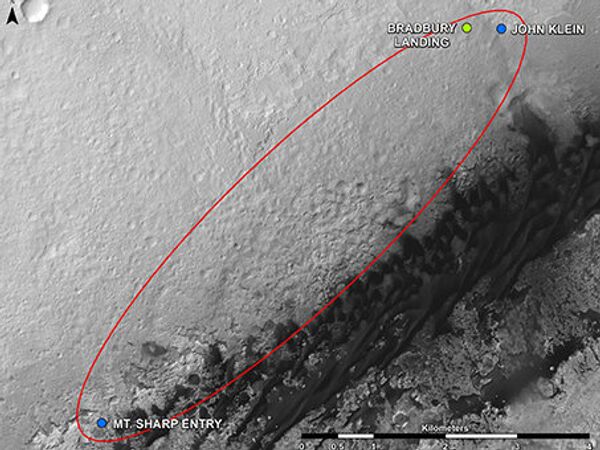WASHINGTON, June 5 (by Karin Zeitvogel for RIA Novosti) – Ten months after it landed on Mars, NASA’s Curiosity rover has reached a turning point in its mission and is getting ready for a road trip to a massive Martian mountain, where scientists hope it will help them to learn more about the Red Planet, NASA said Wednesday.
“We’ve reached the biggest turning point in the mission,” Guy Webster of NASA’s Jet Propulsion Laboratory (JPL) told RIA Novosti.
After spending the last six months exploring Gale Crater, where Curiosity landed last year, and drilling into different rocks, the rover is switching from probing and analyzing to distance-driving mode as it sets out to cover the five miles (eight kilometers) to Mount Sharp, which is thought to rise 3.4 miles (5.5 kilometers) into the Martian sky, and is the destination that NASA scientists have always eyed for the rover.
If Curiosity were to drive without stopping, NASA thinks it would reach the area around Mount Sharp in 10-12 months, given its max speed of around 0.09 miles per hour (0.14 kph).
“But there will be stopping” along the way to do science, Webster said. So it will likely be much longer before Curiosity reaches the slopes of the Martian mountain, where NASA scientists hope the rover will lift the veil a bit more on Mars’s history by analyzing the different minerals in the older rocks at the bottom of the mountain and younger rocks near the top.
Even before Curiosity leaves Gale Crater to head “southwest” on its road trip to the mountain, NASA scientists want to “follow up on a few things we saw in the crater,” including trying to figure out what sort of rock Curiosity snapped a picture of in Point Lake, Joy Crisp, the deputy project scientist for the Mars Science Laboratory, told a news conference.
“The Swiss-cheese texture suggests that it might be volcanic lava or sedimentary,” Crisp said.
Curiosity drilled into two rocks in Gale Crater, at targets dubbed “John Klein” and “Cumberland”, around nine feet (three meters) away from each other.
Samples taken from the first rock, at John Klein, showed that the crater in which Curiosity landed once had conditions that could sustain microbial life, including essential elements, energy and water. Samples from the second rock target are still being analyzed. Curiosity also found evidence of a streambed in the crater area.
Scientists want to study the geometry of rock layers and structures in the crater to “figure out how fast and in what directions the water was flowing, and what the water depth was when the streams were forming these rocks,” Crisp said.
The rover has put less half a mile (0.73 kilometers) on its clock since it landed on Mars in August last year.
Even with its road trip to Mount Sharp under its belt, Curiosity will still be a long way from matching the record for roving on Mars that was set last week by NASA’s Opportunity rover, which has covered 22.22 miles (35.76 kilometers) since it landed on the Red Planet nine years ago.
The record for driving distance anywhere other than Earth is still held by the Soviet Union's remote-controlled Lunokhod 2 rover, which traveled 23 miles (37 kilometers) on the surface of the moon in 1973.


